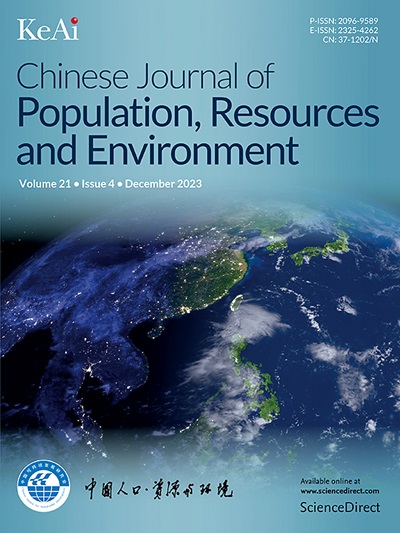替代还是互补?双碳目标下城市制造业集聚的增长与环境效应
IF 4.8
4区 环境科学与生态学
Q2 ENVIRONMENTAL STUDIES
Chinese Journal of Population Resources and Environment
Pub Date : 2025-09-01
DOI:10.1016/j.cjpre.2025.07.004
引用次数: 0
摘要
在中国实施双碳目标的背景下,将传统制造业集聚转变为绿色制造业集聚,对于实现经济发展与环境保护的对接,最终促进中国经济的高质量增长至关重要。本文考察了制造业集聚对经济发展、能源消耗、环境污染和绿色全要素生产率的动态非线性影响。我们建立了一个理论框架,将地方政府约束和激励作为过渡变量,并使用面板平滑过渡回归模型使用2006 - 2020年中国280个地级以上城市的面板数据。结果表明:第一,在约束和激励条件下,制造业集聚均存在单一阈值效应,超过该阈值效应,制造业集聚对经济发展、能源消费和环境污染的正向影响逐渐减弱;②制造业集聚的时空演化特征表明,传统制造业集聚区正逐步从中西部地区向东部资源型地区扩散,而绿色制造业集聚区则呈逐年萎缩趋势。第三,对比分析表明,在发达国家和发展中国家,当政府约束不超过阈值时,制造业集聚效应最强。然而,在发展中国家,一旦超过这个门槛,绿色转型的动力就会不足。最后,数字基础设施对制造业集聚区绿色转型具有积极的促进作用,但其效果受其他因素的影响。本文章由计算机程序翻译,如有差异,请以英文原文为准。
Alternative or complementary? Growth and environmental effects in urban manufacturing agglomeration under dual carbon goals
In the context of China’s dual carbon goals, transforming traditional manufacturing agglomeration into green manufacturing agglomeration is pivotal in aligning economic development with environmental protection, ultimately contributing to the country’s high-quality economic growth. This study examines the dynamic nonlinear effects of manufacturing agglomeration on economic development, energy consumption, environmental pollution, and green total factor productivity. We developed a theoretical framework that considered local government constraints and incentives as transition variables and employed panel data from 280 cities at or above the prefecture level in China from 2006 to 2020 using a Panel Smooth Transition Regression model. The results reveal that, first, under both constraints and incentives, a single threshold effect exists beyond which the positive impact of manufacturing agglomeration on economic development, energy consumption, and environmental pollution gradually weakens. Second, the spatiotemporal evolution of manufacturing agglomeration shows that traditional manufacturing agglomerations are gradually spreading from the central and western regions to the resource-based regions in the eastern part of the country, while green manufacturing agglomerations are shrinking annually. Third, a comparative analysis indicates that, in both developed and developing countries, manufacturing agglomeration effects are strongest when government constraints do not exceed the threshold. However, in developing countries, when this threshold is surpassed, the momentum for green transformation becomes insufficient. Finally, digital infrastructure positively promotes the green transformation of manufacturing agglomerations, although its effects are influenced by other factors.
求助全文
通过发布文献求助,成功后即可免费获取论文全文。
去求助
来源期刊

Chinese Journal of Population Resources and Environment
ENVIRONMENTAL STUDIES-
CiteScore
4.30
自引率
1.10%
发文量
791
审稿时长
79 days
期刊介绍:
The Chinese Journal of Population, Resources and Environment (CJPRE) is a peer-reviewed international academic journal that publishes original research in the fields of economic, population, resource, and environment studies as they relate to sustainable development. The journal aims to address and evaluate theoretical frameworks, capability building initiatives, strategic goals, ethical values, empirical research, methodologies, and techniques in the field. CJPRE began publication in 1992 and is sponsored by the Chinese Society for Sustainable Development (CSSD), the Research Center for Sustainable Development of Shandong Province, the Administrative Center for China's Agenda 21 (ACCA21), and Shandong Normal University. The Chinese title of the journal was inscribed by the former Chinese leader, Mr. Deng Xiaoping. Initially focused on China's advances in sustainable development, CJPRE now also highlights global developments from both developed and developing countries.
 求助内容:
求助内容: 应助结果提醒方式:
应助结果提醒方式:


